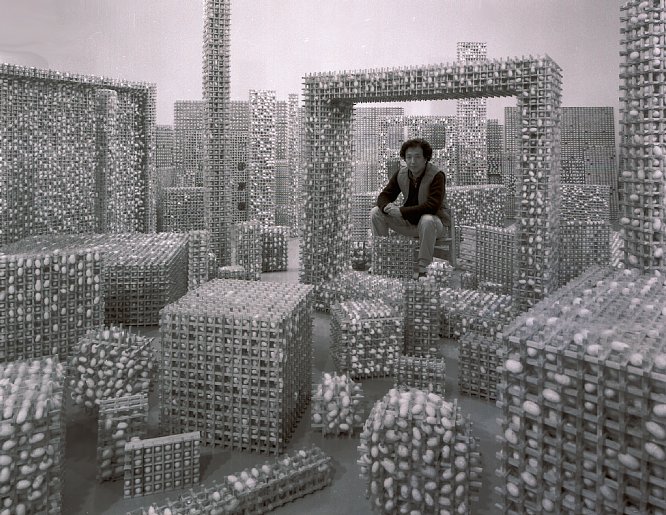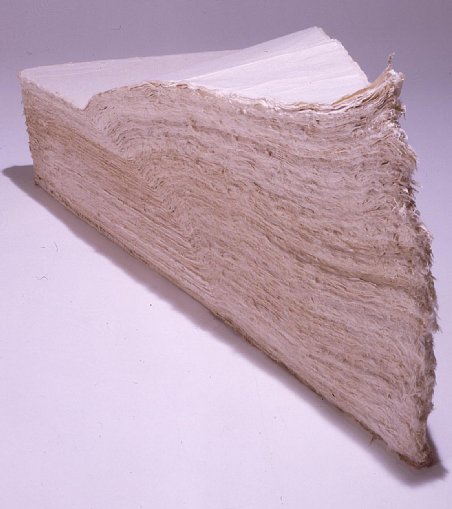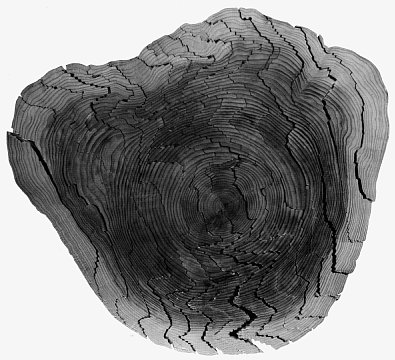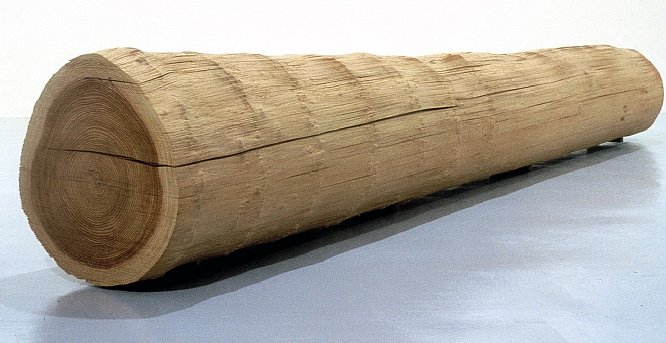| The art of Kadonaga Corpus Christi Caller Times By David Pickering (STAFF WRITER) Sund ay, August 28, 1988 iENTERTAINMENTj |
 |
| Photos by Kazuo Shuzu and Hisashi Mochizuki, courtesy of the Art Museum of South Texas |
  |
 |
| Artist Kazuo Kadonaga Sits amid some of his silk-worm-cocoon, pine and
cedar creations (top photo). Above is a cedar log sliced with a veneer saw and reassembled. At left are one of his bundles of handmade paper and a cross-section view of ceder |
|
| The exhibit at the Art Museum of South Texas reflects a Japanese art movement which puts its emphasis on respect for natural materials |
It's another world at the Art Museum of South Texas right now. You start to feel that as you go in the door and the feeling grows as you pass among the works on display.
The art being exhibited is by the Japanese artist Kazuo Kadonaga, so perhaps this is Kadonagafs world. Except it really isn't, at least not primarily.
You may enter the world of Picasso when you enter a Picasso show, and the same might be said of shows by most other Western artists. but this exhibit, titled gKazuo Kadonaga: Wood/Paper/Bamboo/Silk,h is different. Kadonaga is not so much an artistic gmaster.h like Picasso, as an obedient gservant.h The world of this show is primarily that of the world which he serves, which is the natural world.
Here is a great log which Kadonaga has subtly worked upon, but less in the spirit of creating an object than in the spirit of revealing the essence of what already exists. That same spirit prevails in bundles of handmade paper, lengths of bamboo and some of the artist's most famous creations - silkworm cocoons encased in cedar frameworks.
These latter works were among those featured in a December New Yorker article.
Kadonaga is among artists who have been influenced by a movement in Japan that was called gMono-ha.h usually translated as gthe school of things.h A primary ingredient in the movement was a respect for natural materials ? and, as practiced by some artists, a respect for the gsacred qualityh of natural materials. A precursor of that attitude can be found in the ancient Japanese religion of Shintoism, which features a reverence for divine spirits (kami) that are believed to inhabit trees, rocks and other features of the natural world.
One of the best descriptions of Mono-ha, which flourished in the 1960s, is contained in a recent article by Janet Koplos in Sculpture magazine. An excerpt from the article follows: "The works were direct, ephemeral, and anonymous, but they were never impersonal. They retained a modest, human scale relating to what a person could handle or accomplish and often . . . showed the hand of the maker (but not his ego). This may he the genius of Mono-ha and the aspect that best distinguishes it from American art movements of the same period. The works retained their humanity without assuming man to be the center of the universe. The works were never as coldly, industrially repetitive as sculpture by Donald Judd or Carl Andre, they never had the brutal and threatening qualities of Richard Serra's sculptures and they never took as a goal the avoidance of intimacy or the sensuousness of materials, as Robert Morris advised. Mono-ha was a positive philosophy, intended to reconcile man and nature by recognizing the inherent character and worth of the material world without succumbing to elitist preciousness or losing sight of the fact that a!1 things arc transient.h
Kadonaga is among Japanese artists who are clearly inspired by that spirit, as is apparent from one of his statements included in this showfs catalogue gI am not interested in creating beautiful objects. What is of interest to me is discovering and disclosing the natural beauty of natural materials,h
And itfs the materials to which the viewer is drawn, in an act of empathy, at this show. To be sure, wefre aware. that the artist has been at work. But the feeling here is primarily a feeling of walking amid what might be described as ga forest of the naturally sacred.h The artist, one senses, only acted as an intermediary in bringing it to us.
The show features excellent galle,) notcs on tl]e artist's life, his philosophy and on individual works. They are particularly helpful in an exhibit of this kind since it won't be apparent to most viewers exactly what alterations the artist has made in some materials.
As a case in point, there's a huge log near the main entrance. At first glance, it looks like an ordinary log. Then you start to notice thatfs there something vary compelling about this particular piece of wood. The program notes inform us that Kadonaga sliced the log into very thin layers, using a veneer saw, then reassembled it. As a result, this is a log which somehow seems gsuperreal.h a log with an inward glow, a log out of a dream, a log that seems to invite us within.
gKazuo Kadonaga: Wood/Paper/bamboo/Silkh was organized by the AMST and will travel from here to the Blue Star Space gallery in San Antonio.
The show will be on display at the AMST through Oct. 2. Hours at the museum. 1902 N. Shoreline, are from noon to 5 p.m. on weekends, from l0 a.m. to 5 p.m., Tuesday through Friday. It is closed Mondays.
In connection with the Kadonaga show, an exhibition of art by Japanese children also is on display in the museumfs lower gallery.
Other events in connection with the Kadonaga exhibit include a series of films by Japanese directors and a series of lectures on Japanese art techniques.
Movies in the Thursday film series include Yasujiro Ozufs gTokyo Story,h about generational conflicts in modern-day Japan, Sept. 8; Kenji Mizoguchifs gUtamaro and His Five Women,h about the life of the great 18th century Japanese printmaker, Scpt. 15; and Masahiro Shinodafs gDemon Pond,h about three people and a spirit entrapped in a pond, Sept. 22. Showtime , for all films is 7 p.m. Ticket, arc $3, $2 for museum members.
Lectures include a talk by Dinah Bowman, a noted local practitioner of the art of gyo-taku, or fish printing, at I p.m. on Saturday, Sept. 10 ($5. $4 for members); a lecture at noon on Friday, Sept. 23, about traditional handicrafts of modern Japan (free); a demonstration of the art of origami by Pat Clements of the Museum of Oriental Cultures at 1p.m. on Saturday. Sept. 24 ($5. $4 for. members); and a free lecture by Clements about origami at noon on Friday. Sept. 30. For, more information, call the AMST at 844-3844.